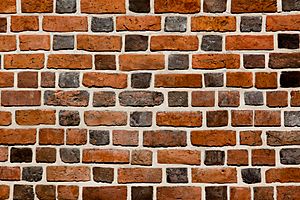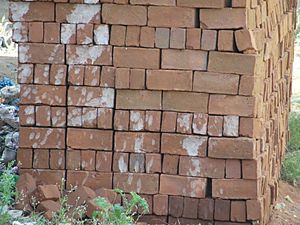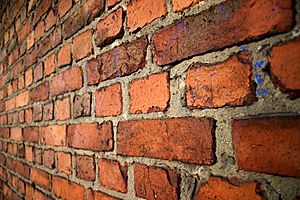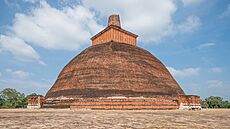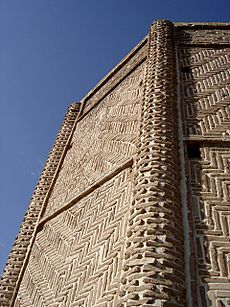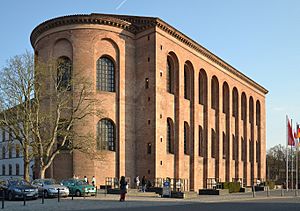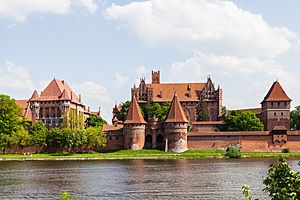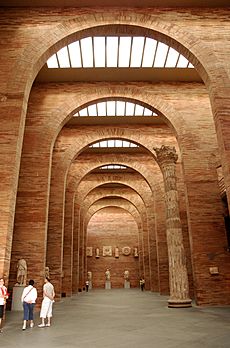Brick facts for kids
A brick is a strong, man-made block used for building. People use bricks to create walls, houses, and even paths to walk on. Bricks are usually made from clay, sand, and a material called lime. Sometimes, they are made from concrete. These blocks are either hardened by fire in an oven or simply dried in the sun.
Most bricks are made from clay. The clay is shaped in special molds or cut with wires. After shaping, these bricks are baked in a very hot oven. The type of clay used gives bricks their different colors.
People who build with bricks are called masons. They use a special mixture called mortar to stick bricks together. Bricks can be laid in many cool patterns. A common pattern is called "running bond." A single row of bricks in a wall is known as a "course."
Bricks used for outdoor paths and driveways are often called "pavers." There are also "engineering bricks" which are super strong. These are used for walls that need to hold a lot of weight. They are made from better clays and baked at higher temperatures, making them more expensive.
Contents
History of Bricks
Early Bricks in the Middle East and South Asia
The very first bricks were made from mud and dried in the sun. These "mudbricks" were found in places like Tell Aswad, dating back over 9,500 years ago! People in ancient towns like Çatalhöyük and Jericho also used mudbricks around 7,000 BC.
Later, people in Mesopotamia (a region in the Middle East) discovered how to make "fired bricks" around 5000 to 4500 BC. These bricks were baked in ovens, making them much stronger. Ancient Mesopotamian bricks often followed a rule: their width was twice their thickness, and their length was twice their width.
In South Asia, people in Mehrgarh also built with sun-dried mudbricks. Later, cities in the Indus Valley, like Mohenjo-daro and Harappa, used fired bricks as early as 3000 BC. These cities built amazing structures with baked bricks, such as the Great Bath at Mohenjo-daro. Bricks in the Indus Valley were very uniform, usually in a 1:2:4 ratio (thickness:width:length). As the Indus civilization declined, their brick-making skills spread to other cities in India.
Around 604 BC, bricks were even used to build wonders like the Hanging Gardens of Babylon. These gardens featured special "glazed fired bricks" that had a shiny, colorful surface.
Bricks in Ancient China
The first fired bricks in China appeared around 4400 BC at a walled settlement called Chengtoushan. These early bricks were red and used for house floors. By 3300 BC, fired bricks were used to pave roads and build foundations.
For a long time, Chinese builders mostly used wood, mud, and packed earth. Fired bricks didn't play a big role in large buildings until the 3rd century BC. They started being used for underground tombs. The oldest brick building still standing above ground is probably the Songyue Pagoda, built in 523 AD.
By the end of the 3rd century BC, China was mass-producing fired bricks. China's first Emperor, Qin Shi Huangdi, used millions of bricks to pave the floors for his famous Terracotta Army. The floors of the three pits had about 230,000 bricks! Fired bricks also started appearing in Chinese city walls during the Eastern Han dynasty (25 AD-220 AD).
A book from 1103, called Yingzao Fashi, described how bricks were made and glazed in China. Another book from the 17th century, Tiangong Kaiwu, explained the process. It said that the kilnmaster (the person in charge of the oven) had to make sure the temperature was just right. The workers mixed clay and water, trampled it with oxen, and scooped it into wooden frames. They smoothed the bricks, stamped them with where they came from, and loaded them into kilns. It was very hard work!
Bricks in Europe
Ancient civilizations around the Mediterranean Sea, like the Greeks and Romans, also started using fired bricks. By the early 1st century AD, the Romans were making lots of standardized fired bricks. Roman armies even had mobile ovens (kilns) and built huge brick structures all over their empire. They used bricks for walls, arches, forts, and aqueducts. Famous Roman brick buildings include the Herculaneum gate of Pompeii and the Baths of Caracalla.
During the Early Middle Ages, bricks became popular in Northern Europe. This was especially true in places that didn't have much natural stone. A unique style of brick architecture, called "brick Gothic," developed there. You can still see examples of this style in countries like Denmark, Germany, and Poland.
This brick style later changed into "Brick Renaissance" as new building ideas from Italy spread north. Buildings started to have lower roofs, symmetrical fronts, round arches, and columns.
Moving large amounts of bricks and other building materials was very expensive for a long time. This changed with the development of modern transportation like canals, roads, and railways.
Bricks in the Industrial Era
Brick production grew a lot during the Industrial Revolution, especially in England. Factories needed to be built quickly and cheaply, so bricks became a popular choice over stone. In London, bright red bricks were chosen to make buildings easier to see in the city's thick fog, helping to prevent accidents.
Making bricks by hand slowly changed to using machines in the early 1800s. One of the first successful brick-making machines was patented by Henry Clayton in England in 1855. It could make up to 25,000 bricks a day with very little human help! Another machine, the 'Stiff-Plastic Brickmaking Machine', was patented even earlier in 1853 by Bradley & Craven Ltd.
By the late 1800s, the Hudson River region in New York State became the world's biggest brick-making area. It had 130 brickyards employing 8,000 people. At its busiest, about 1 billion bricks were made each year! Many of these bricks were sent to New York City for its growing construction industry.
In the early 1900s, tall office buildings started to be built using cast iron, steel, and concrete. Bricks were not as good for very tall skyscrapers. For example, the Monadnock Building in Chicago, built in 1896, needed extremely thick brick walls to support its 17 floors.
Today, bricks are mostly used for small to medium-sized buildings. Steel and concrete are still better materials for very tall high-rise buildings. Bricks are often made from shale, a type of rock that easily splits into thin layers.
Images for kids
See also
 In Spanish: Ladrillo para niños
In Spanish: Ladrillo para niños


